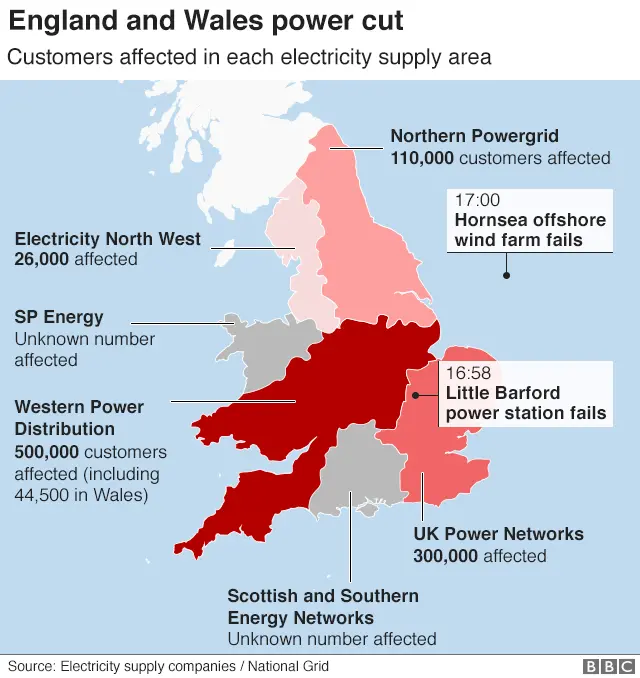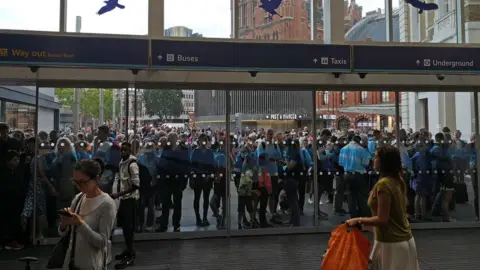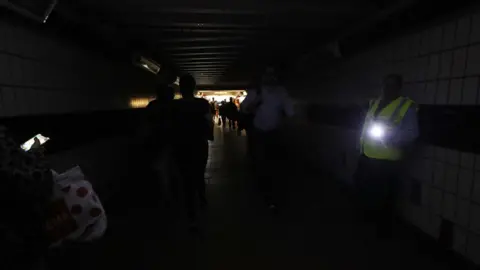UK power cut: National Grid promises to learn lessons from blackout
National Grid has said it will "learn the lessons" after nearly one million people across England and Wales lost power on Friday.
But director of operations Duncan Burt told the BBC that its systems "worked well" after the "incredibly rare event" of two power stations disconnecting.
He said he did not believe that a cyber-attack or unpredictable wind power generation was to blame.
The government has announced an investigation into what happened.
Business Secretary Andrea Leadsom said she is asking the Energy and Emergencies Executive Committee to carry out the investigation, which will look at whether National Grid's procedures are "fit for purpose".
Regulator Ofgem has demanded an "urgent detailed report" into what went wrong.
It said it could take enforcement action, including a fine, after train passengers were stranded, traffic lights failed to work and thousands of homes lost power during the blackout.
National Grid power was restored by 17:40 BST on Friday but some train services continued to be disrupted on Saturday.
The power cut happened at about 17:00 BST on Friday, National Grid said, with blackouts across the midlands, the south east, south west, north west and north east of England, and Wales.
National Grid said its systems were not to blame.
Industry experts said a gas-fired power station at Little Barford, Bedfordshire, failed at 16:58 followed, two minutes later, by the Hornsea offshore wind farm disconnecting from the grid.
Speaking on BBC Radio 4's Today programme, Mr Burt acknowledged the "immense disruption" the blackout had caused.
He said the near-simultaneous loss of two generators was more than the grid was routinely prepared for, prompting automatic safety systems to shut off power to some places.


"We think that worked well; we think the safety protection systems across the industry, on generators and on the network, worked well to secure and keep the grid safe, to make sure that we preserved power to the vast proportion of the country," he said.
But he said the industry needed to examine whether these safety systems were set up correctly to have "minimal impact" on people's daily lives.
RWE, owner of the Little Barford power station, said it shut down temporarily on Friday as a routine response to a technical issue, and called for National Grid and Ofgem to investigate the "wider system issues".
And Orsted, the owner of the Hornsea offshore wind farm, said automatic systems on Hornsea One "significantly reduced" power around the same time others failed.
A spokesperson added: "We are investigating the cause, working closely with National Grid System Operator, which balances the UK's electricity system."
Police were called to help travellers during the huge disruption on the railways on Friday, with delayed passengers stranded for hours.
Disruption continued into Saturday for some routes.
- London North Eastern Railway, which runs between King's Cross and the north of England and Scotland, said services were returning to normal, but a small number of trains were cancelled
- Great Northern services are still facing disruption and passengers are being advised to check their train's status before travelling
- Thameslink services have returned to normal.
Govia Thameslink Railway (GTR), which operates Thameslink, Southern, Great Northern and Gatwick Express, says it is investigating why the power cut had such a severe effect on its trains.
Thameslink trains were particularly badly impacted as GTR had to deploy technicians to manually restart trains north of London.
 PA Media
PA MediaShadow business and energy secretary Rebecca Long Bailey said the impact of the power cut was "unacceptable" at a time when National Grid reported £1.8bn in profits and increased dividends to shareholders.

The German-built trains that left passengers stranded
By Ben Ando, BBC News correspondent
Yesterday's power outage caused chaos for thousands of rail passengers left stranded as the electric trains they were on ground to a halt when the power supply went dead.
But although the National Grid restored power inside a couple of hours, many passengers remained stuck on hot, stuffy trains because the drivers couldn't get them started again and had to wait for technicians to come out.
The trains worst affected are the relatively new Class 700 and Class 717 commuter trains built in Germany by Siemens to specifications laid down by the Department for Transport.
They were introduced onto the British network for Thameslink and Great Northern services from 2014.
When the power died, the trains would have switched to back up batteries to keep essential systems going.
 Lily Winnan
Lily WinnanBut getting the trains restarted once the power came back was not straightforward. Drivers found that in some cases the on-board computers had shut systems down more fully, so a technician was needed.
The Class 700 fleet is normally fast and efficient, but GTR has already launched an investigation with Network Rail and Siemens to examine what went wrong this time.
And it's likely that the manufacturers will be asked to examine how they respond to serious power failures in future.
Battery performance is also likely to come under scrutiny - a back-up diesel generator cannot be fitted to these trains because they spend much of their lives in long tunnels.

 PA Media
PA MediaKing's Cross was one of the worst-hit stations, with all trains suspended for several hours.
Passenger Dayna McAlpine told BBC Radio 5 Live her train took nearly 13 hours to reach London King's Cross from Edinburgh - a journey which would normally take less than five hours.
"By hour seven things were starting to get pretty tense," she said. "People were threatening to self-evacuate off the train... Food ran out about five hours ago."
Others on social media reported having travelled for 12 hours, while some rail passengers were stuck on trains until the early hours of the morning.
Allow X content?

At the worst point of the power cut, about 500,000 people were affected in Western Power Distribution's area - including 44,500 customers in Wales - while 110,000 Northern Powergrid customers also lost power.
In London and south-east England, 300,000 people were affected, UK Power Networks said, and another 26,000 customers were without power in north-west England.
Northern Powergrid said the problems had affected Newcastle airport and city's metro system.
BBC Radio 5 Live listener Ed, in Woodford Green, north-east London, said he felt "totally cut off" as mobile phone networks were also down.
"You heard all the alarms going off all around. Everything else was pretty eerie and quiet," he said. "There was no way we could know anything - it could be any reason that the power had gone down."
 PA Media
PA Media
At Ipswich Hospital, a back-up generator which was supposed to supply power to outpatient areas did not work after the power cut, causing problems for 15 minutes before power was restored.
